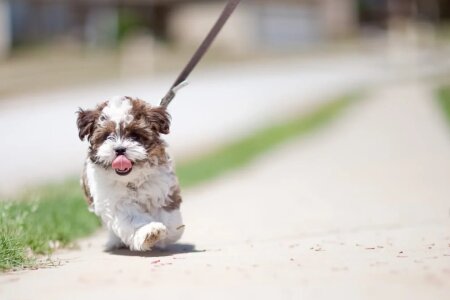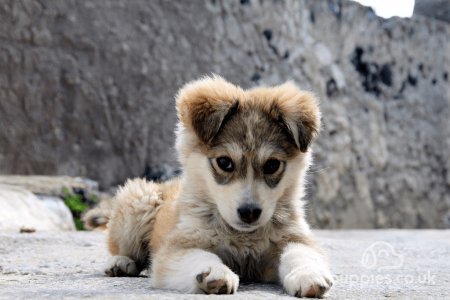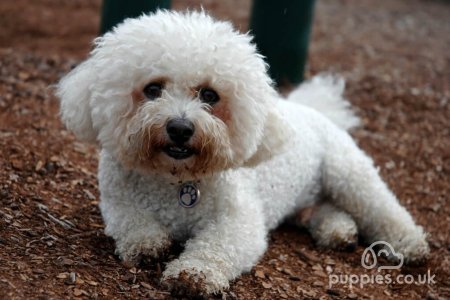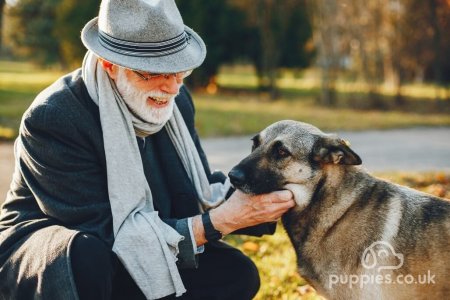Newborn Puppy Socialisation and the Breeders' Role
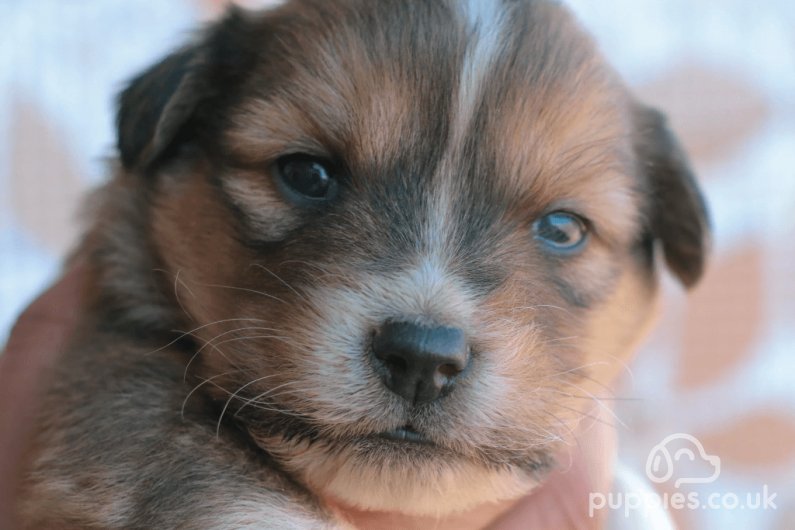
WHAT IS SOCIALISATION AND WHY IS IT IMPORTANT?
Socialisation is a term which has become more important as our knowledge of dogs has advanced. Basically, it is a process by which puppies develop healthy responses towards new and varied stimuli so that they develop coping strategies for their future. The socialisation period is between 3-12 weeks with a tapering effect until 16 weeks. This is a crucial period in a dog’s life when significant brain development takes place and experiences during this time have a huge impact on the emotional resilience of your adult dog. It makes a difference in how your adult dog thinks, learns and feels which, in turn, impacts on their reactions to the world. Socialisation does not take place after this period as the brain chemistry is not the same. Too much, or too little, stimulation during this time can result in dysfunctional emotions. If this occurs, a puppy may be left with an inability to cope with life’s challenges and interactions which lead to fearfulness and reactivity. Experienced trainers could put in place desensitisation programs and training to help these dogs, but I would not recommend that new owners take on these challenges.
Genetics play a large role in your dog’s personality which is clearly seen in the behavioural difference between breeds however the puppy’s learning experiences from 3 weeks of age are just as important for shaping the traits that are already there.
THE ROLE OF A BREEDER
It is important that breeders ensure the development of independent puppies, providing them with the knowledge and skills they need to form social and emotional bonds. Frequently offering puppy a range of high quality experiences means that positive learning can take place. Your chosen breeder is essentially responsible for developing emotional stability. It is vital that they help your puppy to develop coping strategies when faced with low level stress, the resilience to manage frustration and the confidence to learn from rich, novel experiences.
Good breeders ensure they achieve this by having a socialisation program in place between 3-8 weeks to ensure their puppies are behaviourally and emotionally healthy prior to going to their new homes. They should also provide you with guidance, so that you can continue to support your puppy’s progress during this crucial stage, at a suitable level ensuring that positive learning takes place.
NEONATAL PERIOD
This is the name given to the period between 3-16 days and it is a critical phase when the neurological system is forming. Research has shown that breeders can, and should, influence how this system forms, by carrying out early neurological stimulation. Doing this has many benefits including increasing tolerance to stress, providing greater resistance to disease, improved cardiovascular performance and a stronger heartbeat and a more responsive adrenal system. General handling and stroking during this period is good for the puppies however, stimulating the nervous system is different.
There are 5 exercises that breeders can do to assist each puppy with neurological growth and development. These are:
- Tactile Stimulation – whilst holding the pup in one hand the breeder will use a cotton ear stick to gently stimulate the puppy between the toes for 3-5 seconds
- Head held erect – the breeder should hold the puppy in a vertical position where the head is directly above the tail for 3-5 seconds
- Head pointed down – the breeder should hold the puppy in both hands in a vertical position, this time with the head pointing down and tail at the top for 3-5 seconds
- Supine position – the breeder should hold the puppy so that their back is resting in the palm of their hands with the belly pointing towards the ceiling for 3-5 seconds
- Thermal Stimulation – the breeder should find a cold surface like a damp towel and place the puppy on the towel, paws down, allowing it to move freely for 3-5 seconds
CRITICAL SOCIALISATION PERIOD
This period starts at 3 weeks, when the breeder should be working on the startle, recovery cycle. The more times they are startled and recover during this window, the faster their recovery will be as adult dogs. Exposing puppies to a wide variety of loud noises, such as dropping metal bowls, keys, slamming doors, banging objects with different textures to produce different sounds, is extremely important. It is also important that the puppies are exposed to household noises such as vacuum cleaners, hair dryers or other electrical items such as drills, razors, toothpastes, clippers. These household sounds are great to introduce, for short durations, so that the puppies are exposed to sounds of different frequencies.
The puppies should be exposed to 1-2 new items every day since there is no fear at this age so the puppies will approach and interact with anything you give them. Obviously, these should be safe items to help them embrace and see novelty as a good thing.
From 3 weeks old, a larger pen area should be set-up to provide the puppies with enough room for exercise, enrichment and stimulation. There should be a sleeping area which is soft and warm, a play area with suitable flooring for good traction and a toilet area. Puppies will naturally keep the pen clean, which should be encouraged as early as possible. This size of the pen area should be increased as the puppies develop, to help reduce friction in the litter. As early as 3 weeks old, the puppies will begin to start growling and posturing which is helping them learn to use their body language to avoid conflict. This is where they are learning not to hurt each other and the breeder should know not to intervene with this process, to ensure each puppy gains the necessary skills to avoid conflict in the future.
Early interactions between the bitch and the puppies is so important and breeders should help nurture this relationship by providing an area where the bitch can escape from the puppies. Teeth are emerging and it can start becoming uncomfortable for the bitch so, being able to escape when she needs to, will help her feel relaxed and happy. Clipping the claws of the puppies will help make feeding more comfortable for the mother, as well as providing some early desensitisation experiences for the puppies. Claw clipping, carried out whilst puppies are asleep, not only helps reduce paw sensitivity but also ensures that the puppies walk correctly as their bones and tissue develop.
Between 3 and 4 weeks, the breeder should be providing both passive and active challenges. Passive challenges can be provided in the form of novel items, toys, different textures, surfaces and sounds (household noises, radio, different television channels and desensitisation recording for puppies) and new social interactions with people, children and other adult dogs. Active challenges, where the puppy is presented with a problem to solve or a training task, could involve the puppies in negotiating obstacles to get to their food or barrier games, where they begin to build tools to cope with frustration. These kinds of activities should be offered in new areas of the house or garden to ensure they acclimatise to new places with new sights, sounds and smells. Puppies that overcome any self-doubt. e.g. thinking they are not able to get over an obstacle, are going to become much more confident and calmer as adult dogs. These challenges should continue throughout the time with the breeder as it has been scientifically proven that enriched environments promote an increase in brain mass and neural connections, which improves their ability to learn, their emotional stability and coping mechanisms to deal with stress.
Communication is a two-way dialogue that enables connections to be formed between you and your puppy. Puppies should start learning as early as possible to communicate with us in appropriate ways. Jumping up is a way they would naturally use to communicate, but this isn’t a behaviour that most people want. Breeders can start to introduce the puppies to communication processes from 4 weeks by introducing a marker sound or word, which tells the puppy they are correct. This is trained using classical conditioning so that a positive emotion is formed with it, preparing the puppy to understand that their behaviour has an impact. Different breeders may teach different things. My online course has details of how you can train in a way that builds engagement with and confidence in their interactions. https://www.click2heel.thinkifc.com
This training needs to take place with individual puppies, promoting further bonding with people, an important first step in preparing them for separation.
At 5 weeks old, the puppies go through a mild fear imprinting period, meaning that they can be more sensitive to single event learning. This period must be carefully managed to ensure that the individual needs of each puppy is catered for. Breeders can continue to expose the puppies to sights, smells and sounds that they have previously been exposed to but with caution, providing plenty of safe areas for puppy to retreat to should they feel the need to. High rise beds, portable carriers or large cardboard boxes, within the enrichment areas are great places for the puppies to seek shelter in.
By 6 weeks old, breeders should increase exposure to stimuli again and this is a great time to have the puppies working with other people to further increase social skills. This is the age at which they are most curious, with a peak in the socialisation development where fear levels are low. It is good for the puppies to experience different pieces of equipment with several experienced people at this stage. The types of experiences that the puppy has during this period will have a strong effect on how they interact with humans as adult dogs.
High levels of exposure to a wide range of experiences should continue until the puppies are 8 weeks old when the next fear period may start. This is often the time when puppies are leaving the litter to go to their new homes, so there is plenty of change going on! Be sympathetic to this fact and make the transition as smooth as you can for them, controlling new exposure at a level suitable for your individual puppy.
The breeder should give you some insight into the personality of the puppy and how to continue the socialisation period. From 9-12 weeks the puppy enters an environment awareness period when exposure to different environments is important. This can be done safely, following my complete puppy training program. From 12-16 weeks is the seniority classification period also known as the "age of cutting teeth", and the age of independence. This is the end of the window for effective socialisation, although socialisation and exposure must continue throughout adolescent to sexual maturity and slightly beyond to ensure your adult dog can cope with new and varied situations
Remember socialisation begins with the breeder and continues with you. Learn more with our full training course HERE






